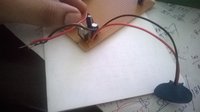quagmire
Allllright !
^ Shah, I recommend you use a phone/webcam as a primary camera to completely scan the cube. An image processing algorithm running on (say OpenCV) phone/laptop will accurately give the colors and the individual turns that you have to make. You can then actuate the result using Arduino.
It is possible to interface a camera with Arduino (check Omnivision cameras) but it is not possible to achieve a decent frame rate or resolution that you require, plus those cameras are expensive and not available in India. Webcams as cheap as 6$ are available online..
Else you could ditch the Arduino and graduate to a Raspberry Pi or BeagleBone which is a complete solution not requiring a PC at all.
It is possible to interface a camera with Arduino (check Omnivision cameras) but it is not possible to achieve a decent frame rate or resolution that you require, plus those cameras are expensive and not available in India. Webcams as cheap as 6$ are available online..
Else you could ditch the Arduino and graduate to a Raspberry Pi or BeagleBone which is a complete solution not requiring a PC at all.


 to get the purpose even after watching the video thrice.
to get the purpose even after watching the video thrice. 
